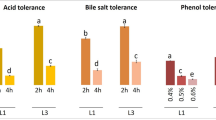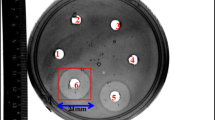Abstract
Macrococcus spp. are Gram-positive cocci that belong to the Staphylococcaceae family; they are closely related to staphylococci, but, unlike staphylococci, they are not considered as human pathogens. Macrococcus spp. are recognized as relevant veterinary pathogens, and their presence has been reported in food products of animal origin. Macrococcus caseolyticus, the most studied species of the Macrococcus genus, is associated with the development of aroma and flavor in fermented foods and is, thus, used as starter cultures in fermentations. However, certain important issues regarding food safety must be taken into account when employing these microorganisms in fermentations. Recent studies have reported the presence of genes associated with resistance to methicillin and other antibiotics in M. caseolyticus. This can be harmful to human health as these genes can be transferred to other bacteria present in the food, mainly staphylococcal species. This work, therefore, aims to highlight the importance of a more critical view on the presence of macrococci in foods and the possible indirect risks to human health.

Similar content being viewed by others
References
Kloos WE, Ballard DN, George CG, Webster JA, Hubner RJ, Ludwig W et al (1998) Delimiting the genus Staphylococcus through description of Macrococcus caseolyticus gen. nov., comb. nov. and Macrococcus equipercicus sp. nov., and Macrococcus bovicus sp. no. and Macrococcus carouselicus sp. nov. Int J Syst Bacteriol 48:859–877. https://doi.org/10.1099/00207713-48-3-859
Gotz F, Bannerman T, Schleifer KH (2006) The genera Staphylococcus and Macrococcus. In M. Dworkin, S. Falkow, E. Rosenberg, S. Karl-Heinz, & E. Stackebrandt (Eds.), Bacteria: Firmicutes, Cyanobacteria: Vol. 4. The Prokaryotes. New York.
LPSN (2020) List of Prokaryotic names with Standing in Nomenclature https://lpsn.dsmz.de/search?word=macrococcus. Accessed 12 May 202
Fontana C, Cappa F, Rebecchi A, Cocconcelli PS (2010) Surface microbiota analysis of Taleggio, Gorgonzola, Casera, Scimudin, and Formaggio di Fossa Italian cheeses. Int J Food Microbiol 138:205–211. https://doi.org/10.1016/j.ijfoodmicro.2010.01.017
Randazzo CL, Torriani S, Akkermans AD, de Vos WM, Vaughan EE (2002) Diversity, dynamics, and activity of bacterial communities during production of an artisanal Sicilian cheese as evaluated by 16S rRNA analysis. Appl Environ Microbiol 68:1882–1892. https://doi.org/10.1128/aem.68.4.1882-1892.2002
Schwendener S, Nigg A, Collaud A, Overesch G, Kittl S, Phumthanakorn N, Perreten V (2019) Typing of mecD islands in genetically diverse methicillin-resistant Macrococcus caseolyticus strains from cattle. Appl Environ Microbiol 85(19):e01496-e1519. https://doi.org/10.1128/AEM.01496-19
Machado MAA, Ribeiro WA, Toledo VS, Ramos GLPA, Vigoder HC, Nascimento JS (2020) Antibiotic resistance and biofilm production in Gram positive catalase positive cocci isolated from Brazilian pasteurized milk. J Food Qual Hazards Control 7:67–74. https://doi.org/10.18502/jfqhc.7.2.2886
Baba T, Kuwahara-Arai K, Uchiyama I, Takeuchi F, Ito T, Hiramatsu K (2009) Complete genome sequence of Macrococcus caseolyticus strain JCSCS5402, reflecting the ancestral genome of the human pathogenic staphylococci. J Bacteriol 191:1180–1190. https://doi.org/10.1128/JB.01058-08
Tsubakishita S, Kuwahara-Arai K, Baba T, Hiramatsu K (2010) Staphylococcal cassette chromosome mec-like element in Macrococcus caseolyticus. Antimicrob Agents Chemother 54:1469–1475. https://doi.org/10.1128/AAC.00575-09
Li G, Du X, Zhou D, Li C, Huang L, Zheng Q, Cheng Z (2018) Emergence of pathogenic and multiple-antibiotic-resistant Macrococcus caseolyticus in commercial broiler chickens. Transboundary Emerging Dis 65(6):1605–1614. https://doi.org/10.1111/tbed.12912
Mašlaňová I, Wertheimer Z, Sedláček I, Švec P, Indráková A, Kovařovic V, Krištofová L (2018) Description and Comparative Genomics of Macrococcus caseolyticus subsp. hominis subsp. nov., Macrococcus goetzii sp. nov., Macrococcus epidermidis sp. nov., and Macrococcus bohemicus sp. nov., Novel Macrococci From Human Clinical Material With Virulence Potential and Suspected Uptake of Foreign DNA by Natural Transformation. Front Microbiol 9:1178. https://doi.org/10.3389/fmicb.2018.01178
MacFadyen AC, Fisher EA, Costa B, Cullen C, Paterson GK (2018) Genome analysis of methicillin resistance in Macrococcus caseolyticus from dairy cattle in England and Wales. Microbial genomics 4(8):000191. https://doi.org/10.1099/mgen.0.000191
Gómez-Sanz E, Schwendener S, Thomann A, Gobeli Brawand S, Perreten V (2015) First staphylococcal cassette chromosome mec containing a mecB-carrying gene complex independent of transposon Tn6045 in a Macrococcus caseolyticus isolate from a canine infection. Antimicrob Agents Chemother 59:4577–4583. https://doi.org/10.1128/AAC.05064-14
Cotting K, Strauss C, Rodriguez-Campos S, Rostaher A, Fischer NM, Roosje PJ (2017) Macrococcus canis and M. caseolyticus in dogs: occurrence, genetic diversity and antibiotic resistance. Vet Dermatol 28:559-e133. https://doi.org/10.1111/vde.12474
Schwendener S, Cotting K, Perreten V (2017) Novel methicillin resistance gene mecD in clinical Macrococcus caseolyticus strains from bovine and canine sources. Sci Rep 7:43797. https://doi.org/10.1038/srep43797
Mazhar S, Hill C, Mcauliffe O (2018) The Genus Macrococcus: An insight into its biology, evolution, and relationship with Staphylococcus. In: Advances in Applied Microbiology. Academic Press.
Fuka MM, Wallisch S, Engel M, Welzl G, Havranek J, Schloter M (2013) Dynamics of Bacterial Communities during the Ripening Process of Different Croatian Cheese Types Derived from Raw Ewe’s Milk Cheeses. PLoS ONE 8(11):e80734. https://doi.org/10.1371/journal.pone.0080734
Zhong Z, Hou Q, Kwok L, Yu Z, Zheng Y, Sun Z et al (2016) Bacterial microbiota compositions of naturally fermented milk are shaped by both geographic origin and sample type. J Dairy Sci 99:7832–7841. https://doi.org/10.3168/jds.2015-10825
Resende JA, Fontes CO, Ferreira-Machado AB, Nascimento TC, Silva VL, Diniz CG (2018) Antimicrobial-Resistance genetic markers in potentially pathogenic gram positive cocci isolated from Brazilian soft cheese. J Food Sci 83(2):377–385. https://doi.org/10.1111/1750-3841.14019
Patil SH (2019) Psychrotrophic Microbiota in Milk and Fermented Milk Products. J Pure Appl Microbio 113(2):1257–1266. https://doi.org/10.22207/JPAM.13.2.68
Frazilio DA, de Almeida OGG, Niño-Arias FC, Martinis ECP (2019) Finding a common core microbiota in two Brazilian dairies through culture and DNA metabarcoding studies. J Food Sci Technol 56:5326–5335. https://doi.org/10.1007/s13197-019-04003-1
Mnif S, Jardak M, Yaich A, Aifa S (2020) Enzyme-based strategy to eradicate monospecies Macrococcus caseolyticus biofilm contamination in dairy industries. Int Dairy J 100:104560. https://doi.org/10.1016/j.idairyj.2019.104560
Blaiotta G, Pennacchia C, Villani F, Ricciardi A, Tofalo R, Parente E (2004) Diversity and dynamics of communities of coagulase negative staphylococci in traditional fermented sausages. J Appl Microbiol 97(2):271–284. https://doi.org/10.1111/j.1365-2672.2004.02298.x
Devi KR, Deka M, Jeyaram K (2015) Bacterial dynamics during yearlong spontaneous fermentation for production of ngari, a dry fermented fish product of Northeast India. Int J Food Microbiol 199:62–71. https://doi.org/10.1016/j.ijfoodmicro.2015.01.004
Li L, Olsen RH, Ye L, Yan H, Nie Q, Meng H, Shi L (2016) Antimicrobial resistance and resistance genes in aerobic bacteria isolated from pork at slaughter. J Food Prot 79(4):589–597. https://doi.org/10.4315/0362-028x.jfp-15-455
Geniş B, Tuncer Y (2018) Determination of antibiotic susceptibility and decarboxylase activity of coagulase-negative Staphylococcus and Macrococcus caseolyticus strains isolated from fermented Turkish sausage (sucuk). JFood Process Pres 42(1):e13329. https://doi.org/10.1111/jfpp.13329
Zang J, Xu Y, Xia W, Yu D, Gao P, Jiang Q, Yang F (2018) Dynamics and diversity of microbial community succession during fermentation of Suan yu, a Chinese traditional fermented fish, determined by high throughput sequencing. Food Res Int 111:565–573. https://doi.org/10.1016/j.foodres.2018.05.076
Tshipamba ME, Lubanza N, Adetunji MC, Mwanza M (2018) Molecular Characterization and antibiotic resistance of foodborne pathogens in street-vended ready-to-eat meat sold in south africa. J Food Protect 81(12):1963–1972. https://doi.org/10.4315/0362-028x.jfp-18-069
Santiyanont P, Chantarasakha K, Tepkasikul P, Srimarut Y, Mhuantong W, Tangphatsornruang S, Chokesajjawatee N (2019) Dynamics of biogenic amines and bacterial communities in a Thai fermented pork product Nham. Food Res Int 119:110–118. https://doi.org/10.1016/j.foodres.2019.01.060
Phewpan A, Phuwaprisirisan P, Takahashi H, Ohshima C, Lopetcharat K, Techaruvichit P, Keeratipibul S (2020) Microbial diversity during processing of Thai traditional fermented shrimp paste, determined by next generation sequencing. LWT 122:108989. https://doi.org/10.1016/j.lwt.2019.108989
Parkouda C, Thorsen L, Compaoré CS, Nielsen DS, Tano-Debrah K, Jensen JS et al (2010) Microorganisms associated with Maari, a Baobab seed fermented product. Int J Food Microbiol 142(3):292–301. https://doi.org/10.1016/j.ijfoodmicro.2010.07.004
Arogunjo AO, Arotupin DJ (2018) Millet Cobs: A Source of microbial enzymes. J Microb Biochem Technol 10:124–133. https://doi.org/10.4172/1948-5948.1000405
Ouoba LII, Vouidibio-Mbozo AB, Anyogu A, Obioha PI, Lingani-Sawadogo H, Sutherland JP et al (2019) Environmental heterogeneity of Staphylococcus species from alkaline fermented foods and associated toxins and antimicrobial resistance genetic elements. Int J Food Microbiol. https://doi.org/10.1016/j.ijfoodmicro.2019.108356
Bhowmik T, Marth EH (1990) Rote of Micrococcus and Pediococcus species in cheese ripening: a review. J Dairy Sci 73:859–866. https://doi.org/10.3168/jds.s0022-0302(90)78740-1
Mazhar S, Kilcawley KN, Hill C, McAuliffe O (2020) A Systems-Wide Analysis of Proteolytic and Lipolytic Pathways Uncovers The Flavor-Forming Potential of The Gram-positive Bacterium Macrococcus caseolyticus subsp caseolyticus. Front Microbiol 11:1533. https://doi.org/10.3389/fmicb.2020.01533
Cáceres P, Castillo D, Pizarro M (1997) Secondary flora of Casar de Cáceres cheese Characterization of Micrococcaceae. Int Dairy J 7(8–9):531–536. https://doi.org/10.1016/S0958-6946(97)00045-9
Alkhalaf W, Piard JC, El Soda M, Gripon JC, Desmazeaud M, Vassal L (1988) Liposomes as proteinase carriers for the accelerated ripening of Saint-Paulin type cheese. J Food Sci 53(6):1674–1679. https://doi.org/10.1111/j.1365-2621.1988.tb07813.x
Laranjo M, Elias M, Fraqueza MJ (2017) The use of starter cultures in traditional meat products. J Food Qual. https://doi.org/10.1155/2017/9546026
Cruxen CES, Funck GD, Haubert L, Dannenberg GS, Marques JL, Chaves FC, Silva WP, Fiorentini AM (2019) Selection of native bacterial starter culture in the production of fermented meat sausages: Application potential, safety aspects, and emerging technologies. Food Res Int 122:371–382. https://doi.org/10.1016/j.foodres.2019.04.018
Iacumin L, Comi G, Cantoni C, Cocolin L (2006) Ecology and dynamics of coagulase-negative cocci isolated from naturally fermented Italian sausages. Syst Appl Microbiol 29:480–486. https://doi.org/10.1016/j.syapm.2005.11.006
Xiong W, Sun Y, Zeng Z (2018) Antimicrobial use and antimicrobial resistance in food animals. Environ Sci Pollution Res 25:18377–18384. https://doi.org/10.1007/s11356-018-1852-2
Wang HH (2009) Commensal bacteria, microbial ecosystems, and horizontal gene transmission: adjusting our focus for strategic breakthroughs against antibiotic resistance. In Jaykus L, Wang H, Schlesinger L (ed) Food-Borne Microbes. ASM Press, Washington, DC.
Wang H, McEntire JC, Zhang L, Li X, Doyle M (2012) The transfer of antibiotic resistance from food to humans: facts, implications and future directions. Rev Sci Tech 31(1):249–260. https://doi.org/10.20506/rst.31.1.2117
Argudín M, Deplano A, Meghraoui A, Dodémont M, Heinrichs A, Denis O, Nonhoff C, Roisin S (2017) Bacteria from animals as a pool of antimicrobial resistance genes. Antibiotics 6(2):12. https://doi.org/10.3390/antibiotics6020012
Tóth AG, Csabai I, Krikó E, Tozser D, Maróti G, Patai ÁV, Makrai L, Szita G, Solymosi N (2019) Raw milk for human consumption may carry antimicrobial resistance genes. Doi: https://doi.org/10.1101/853333
Rossi F, Rizzotti L, Felis GE, Torriani S (2017) Horizontal gene transfer among microorganisms in food: current knowledge and future perspectives. Food Microbiol 42:232–243. https://doi.org/10.1016/j.fm.2014.04.004
Becker K, van Alen S, Idelevich EA, Schleimer N, Seggewiß J, Mellmann A et al (2018) Plasmid-encoded transferable mecB-mediated methicillin resistance in Staphylococcus aureus. Emerging Infect Dis 24(2):242. https://doi.org/10.3201/eid2402.171074
Schwendener S, Donà V, Perreten V (2020) The novel macrolide resistance genes mef(D), msr(F) and msr(H) are present on resistance islands in Macrococcus canis, Macrococcus caseolyticus and Staphylococcus aureus. Antimicrob Agents Chemother 64(5):e00160-e220. https://doi.org/10.1128/aac.00160-20
Funding
This study was funded by Conselho Nacional de Desenvolvimento Científico e Tecnológico (Grant No. 301394/2015-6).
Author information
Authors and Affiliations
Corresponding author
Additional information
Publisher's Note
Springer Nature remains neutral with regard to jurisdictional claims in published maps and institutional affiliations.
Rights and permissions
About this article
Cite this article
Ramos, G.L.P.A., Vigoder, H.C. & Nascimento, J.S. Technological Applications of Macrococcus caseolyticus and its Impact on Food Safety. Curr Microbiol 78, 11–16 (2021). https://doi.org/10.1007/s00284-020-02281-z
Received:
Accepted:
Published:
Issue Date:
DOI: https://doi.org/10.1007/s00284-020-02281-z




